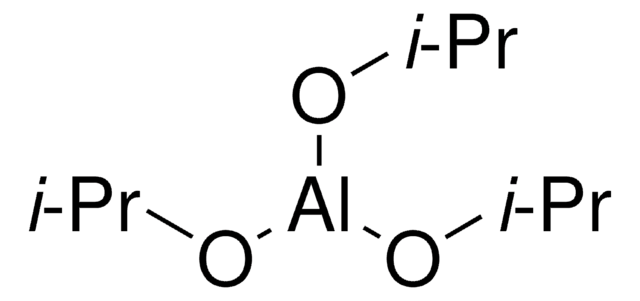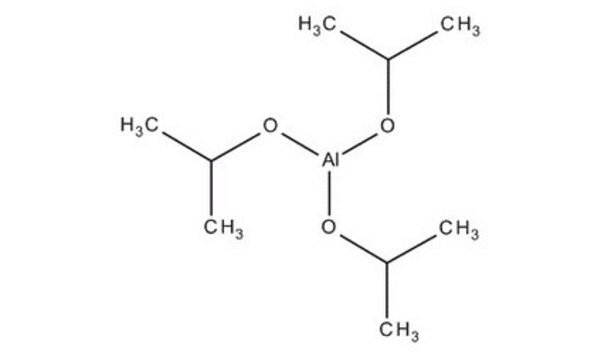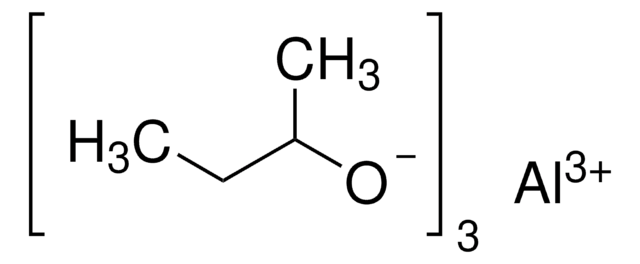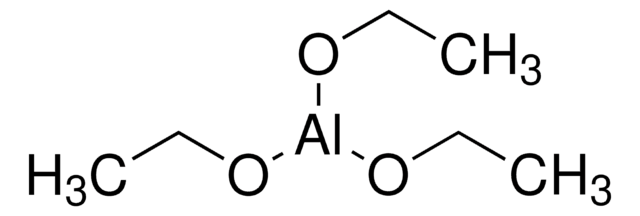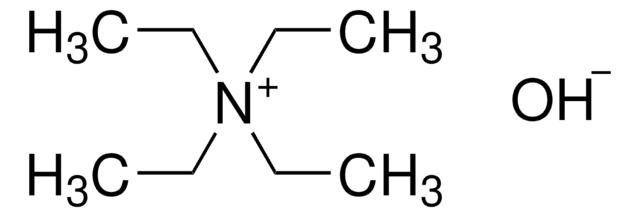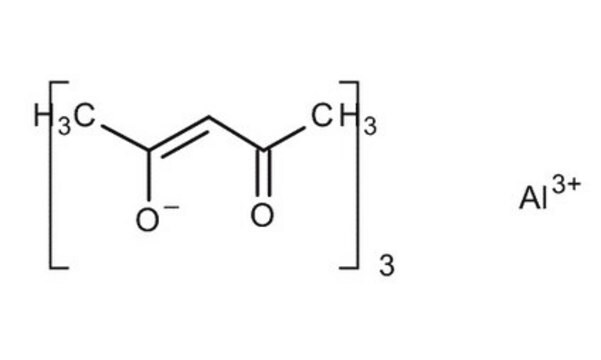Wichtige Dokumente
229407
Aluminiumisopropoxid
≥99.99% trace metals basis
Synonym(e):
AIP, Alkylbenzyldimethylammoniumchlorid, Aluminiumtriisopropoxid
About This Item
Empfohlene Produkte
Qualitätsniveau
Assay
≥99.99% trace metals basis
Form
powder and chunks
solid
Eignung der Reaktion
core: aluminum
reagent type: catalyst
mp (Schmelzpunkt)
128-133 °C (lit.)
Dichte
1.035 g/mL at 25 °C (lit.)
SMILES String
CC(C)O[Al](OC(C)C)OC(C)C
InChI
1S/3C3H7O.Al/c3*1-3(2)4;/h3*3H,1-2H3;/q3*-1;+3
InChIKey
SMZOGRDCAXLAAR-UHFFFAOYSA-N
Suchen Sie nach ähnlichen Produkten? Aufrufen Leitfaden zum Produktvergleich
Allgemeine Beschreibung
Anwendung
- Sol-Gel-Vorläufer bei der Synthese von ZnAl2O4-Pulvern für transparente Keramiken
- Ausgangsmaterial bei der Herstellung von SAPO-34-Zeolithen in Nanogröße mit einer 4-fachen Verlängerung der katalytischen Lebensdauer und deutlich erhöhter Selektivität
- Ausgangsmaterial zur Herstellung von Materialien mit lang anhaltender Lumineszenz für Anzeigegeräte und Bio-Imaging
- Beschichtungsmaterial zur Herstellung von Elektroden für Lithium-Ionen-Batterien zur Verbesserung der Zyklenstabilität und Leistung
- Katalysator für die Alkylierung von Resorcin mit Camphen
Signalwort
Danger
H-Sätze
P-Sätze
Gefahreneinstufungen
Flam. Sol. 1
Lagerklassenschlüssel
4.1B - Flammable solid hazardous materials
WGK
WGK 1
Flammpunkt (°F)
60.8 °F - closed cup
Flammpunkt (°C)
16 °C - closed cup
Persönliche Schutzausrüstung
Eyeshields, Gloves, type P3 (EN 143) respirator cartridges
Hier finden Sie alle aktuellen Versionen:
Besitzen Sie dieses Produkt bereits?
In der Dokumentenbibliothek finden Sie die Dokumentation zu den Produkten, die Sie kürzlich erworben haben.
Kunden haben sich ebenfalls angesehen
Artikel
Nanostructured Materials Through Ultrasonic Spray Pyrolysis
Advanced Inorganic Materials for Solid State Lighting
Nanostructured Materials Through Ultrasonic Spray Pyrolysis
Spectral conversion for solar cells is an emerging concept in the field of photovoltaics, and it has the potential to increase significantly the efficiency of solar cells. Lanthanide ions are ideal candidates for spectral conversion, due to their high luminescence efficiencies and rich energy level structure that allows for great flexibility in the upconversion and downconversion of photons in a wide spectral region (NIR-VIS-UV).
Unser Team von Wissenschaftlern verfügt über Erfahrung in allen Forschungsbereichen einschließlich Life Science, Materialwissenschaften, chemischer Synthese, Chromatographie, Analytik und vielen mehr..
Setzen Sie sich mit dem technischen Dienst in Verbindung.